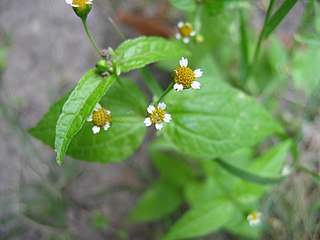
Artemisia vulgaris, the common mugwort, is a species of flowering plant in the daisy family Asteraceae. It is one of several species in the genus Artemisia commonly known as mugwort, although Artemisia vulgaris is the species most often called mugwort. It is also occasionally known as riverside wormwood, felon herb, chrysanthemum weed, wild wormwood, old Uncle Henry, sailor's tobacco, naughty man, old man, or St. John's plant. Mugworts have been used medicinally and as culinary herbs.

Leucanthemum vulgare, commonly known as the ox-eye daisy, oxeye daisy, dog daisy, marguerite and other common names, is a widespread flowering plant native to Europe and the temperate regions of Asia, and an introduced plant to North America, Australia and New Zealand.

Glebionis segetum is a species of flowering plant in the family Asteraceae, probably native only to the eastern Mediterranean region but now naturalized in western and northern Europe as well as China and parts of North America. Common names include corn marigold and corn daisy.

Bellis perennis, the daisy, is a European species of the family Asteraceae, often considered the archetypal species of the name daisy. To distinguish this species from other plants known as daisies, it is sometimes qualified as common daisy, lawn daisy or English daisy.

Glebionis is a small genus of flowering plants in the family Asteraceae, native to Europe and the Mediterranean region. The species were formerly treated in the genus Chrysanthemum, but a 1999 ruling of the International Botanical Congress has resulted in that genus being redefined to cover the species related to the economically important florist's chrysanthemum, thereby excluding the species now included in Glebionis.

Glebionis coronaria, formerly called Chrysanthemum coronarium, is a species of flowering plant in the daisy family. It is native to the Mediterranean region. It is cultivated and naturalized in East Asia and in scattered locations in North America.

Boltonia asteroides, the white doll's daisy, false chamomile, or false aster, is a species of plant native to the United States and Canada. It is found primarily in the Mississippi Valley and Great Plains from Saskatchewan south to Texas and Florida, with isolated populations in the eastern United States. Reports of the species in New England, New York, and the Pacific Northwest appear to be introductions.

Galinsoga parviflora is a herbaceous plant in the Asteraceae (daisy) family. It has several common names including guasca (Colombia), pacpa yuyo, paco yuyo and waskha (Peru), burrionera (Ecuador), albahaca silvestre and saetilla (Argentina), mielcilla, piojito, galinsoga, gallant soldier,quickweed, and potato weed.

Dimorphotheca sinuata, the glandular Cape marigold, Namaqualand daisy, or orange Namaqualand daisy; syn. Dimorphotheca aurantiaca hort.) is a species of plants native to southern Africa. It is also widely cultivated as an ornamental and naturalized in parts of the United States, primarily California and Arizona.

Symphyotrichum laeve is a flowering plant native to Canada, the United States, and Coahuila (Mexico). It has the common names of smooth blue aster, smooth aster, smooth-leaved aster, glaucous Michaelmas-daisy and glaucous aster.

Arctotis stoechadifolia, the African daisy or white arctotis, is a rare species of South African plants in the family Asteraceae. It is a rare plant found only in sand dunes along the west coast of Cape Province.

Verbesina encelioides is a flowering plant in the family Asteraceae. The species is native to many parts of the United States and Mexico. It is naturalized in other parts of North America, the Middle East, Spain, Argentina, Australia and the Pacific islands. Common names include golden crownbeard, gold weed, wild sunflower, cowpen daisy, butter daisy, crown-beard, American dogweed and South African daisy.

Aster amellus, the European Michaelmas daisy, is a perennial herbaceous plant in the genus Aster of the family Asteraceae.

Puccinia horiana is a species of fungus that causes chrysanthemum white rust, is a disease of plant species of the genus Chrysanthemum.

Leucanthemum maximum is a species of flowering plant in the aster family known by the common name max chrysanthemum.

Chrysanthemum × morifolium is a hybrid species of perennial plant from family Asteraceae.

Pteris cretica, the Cretan brake, ribbon fern, or Cretan brake fern, is a species of evergreen fern in the family Pteridaceae, native to Europe, Asia and Africa.

Dimorphotheca pluvialis, common names white African daisy, Cape marigold, weather prophet, Cape rain-daisy, ox-eye daisy, Cape daisy or rain daisy, is a plant species native to South Africa and Namibia. It is sparingly naturalized in scattered locations in California.

Garden marguerites, also known as marguerite daisies, are cultivars of plants in the subtribe Glebionidinae of the family Asteraceae, the great majority being hybrids created in cultivation. One of the genera belonging to the subtribe, Argyranthemum, was introduced into cultivation from the Canary Islands in the 18th century, and modern cultivars are mostly sold and grown under the genus name Argyranthemum or the species name Argyranthemum frutescens, although many are actually intergeneric hybrids. The first such hybrids involved species now placed in the genus Glebionis, but other crosses within the subtribe are known. Breeding has aimed at introducing flower heads in varied colours and shapes while retaining the shrubby habit of Argyranthemum. Garden marguerites are used as summer bedding or grown in containers. Most are only half-hardy. They can be trained into shapes such as pyramids or grown as standards.

Glebionidinae is a small subtribe of flowering plants in the tribe Anthemideae of the family Asteraceae. Its members include species used in the production of garden marguerites.



















